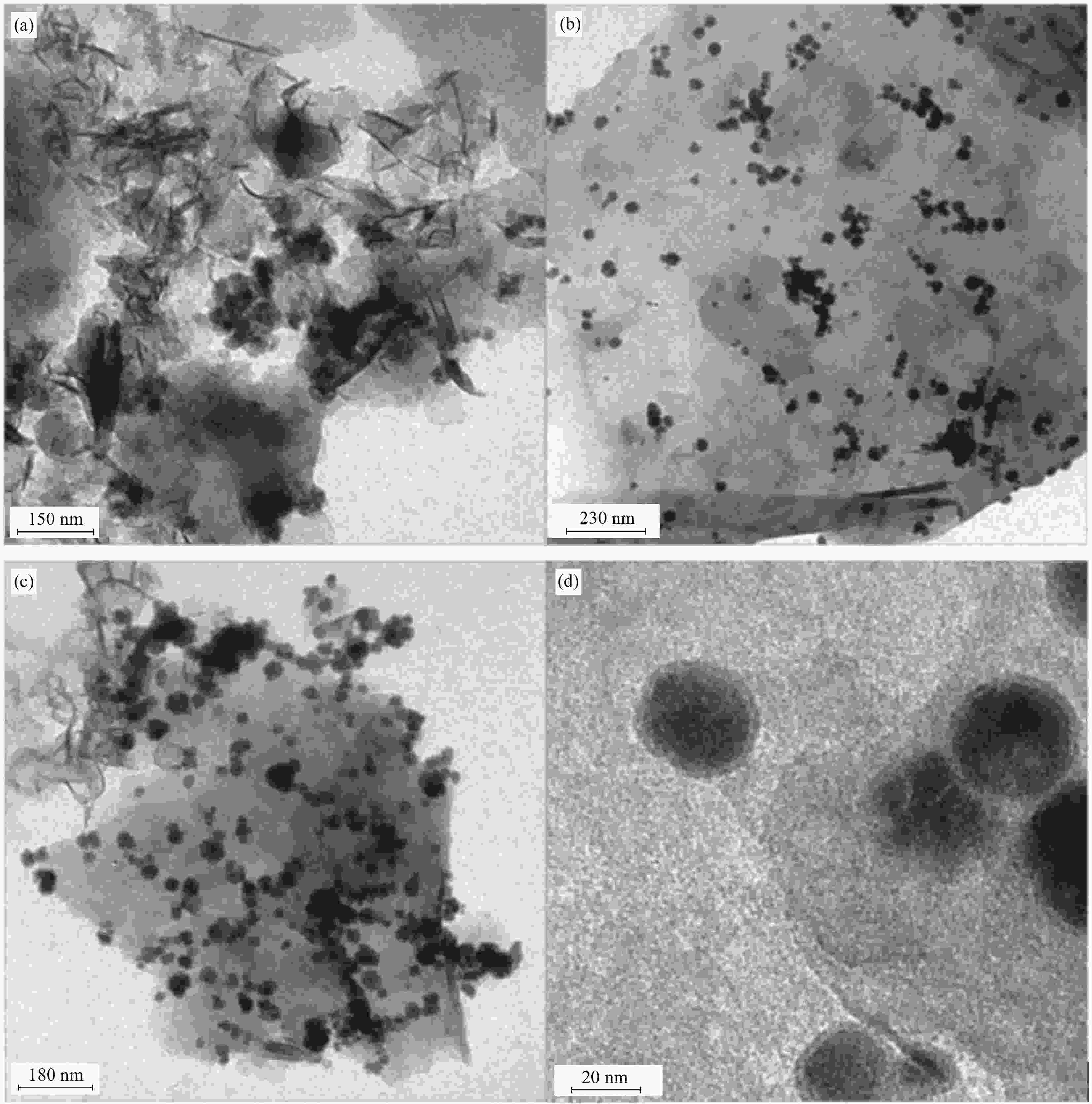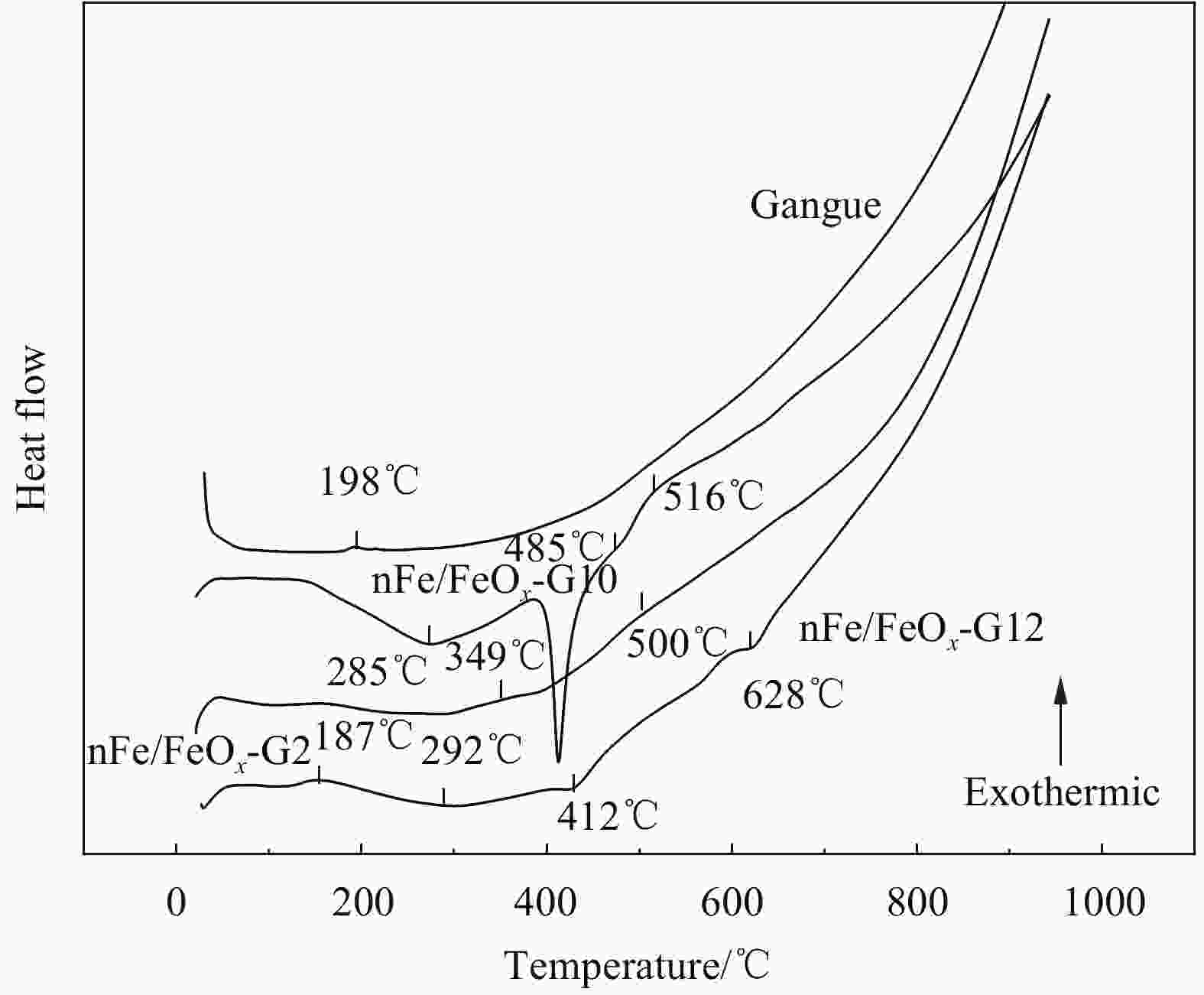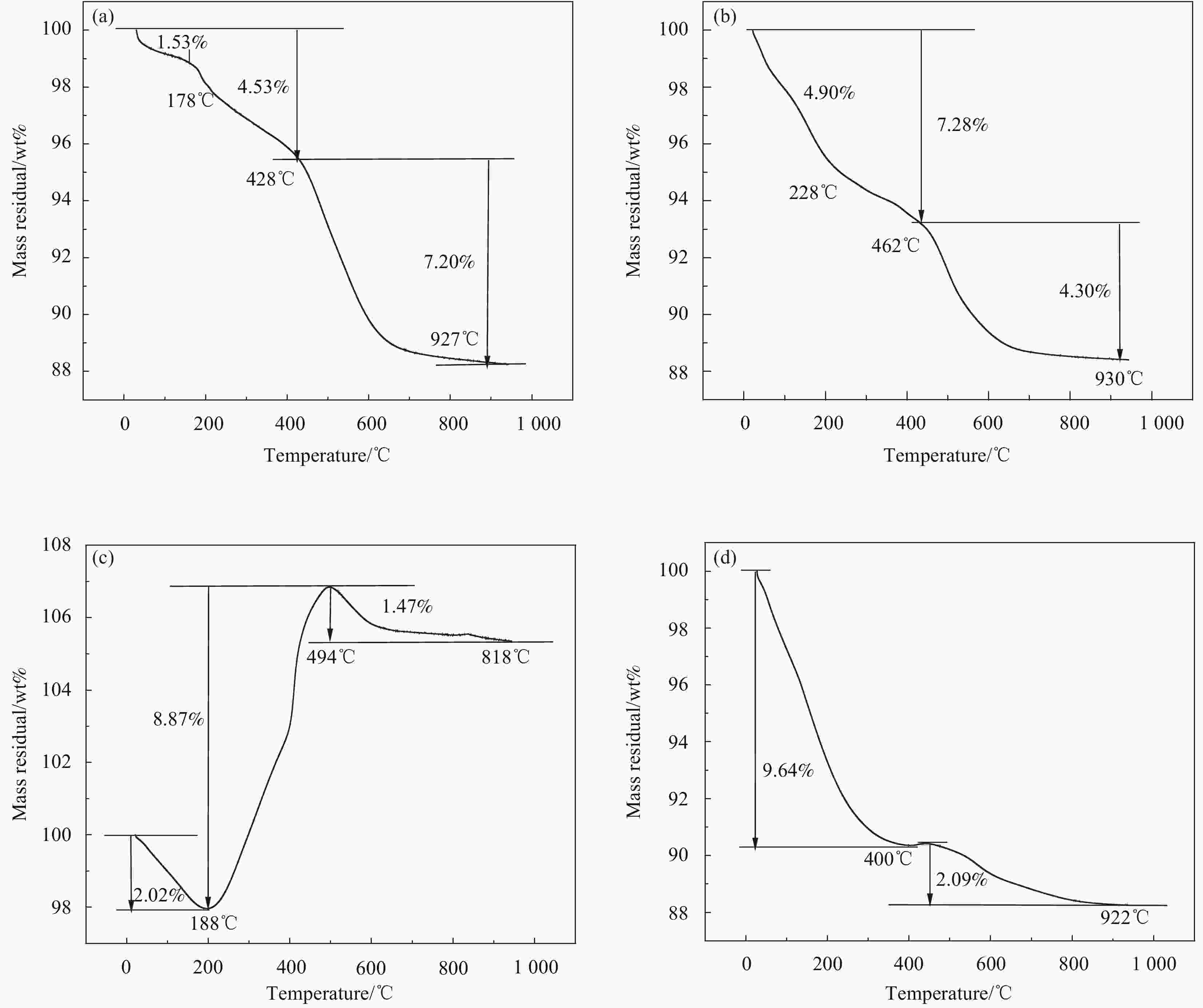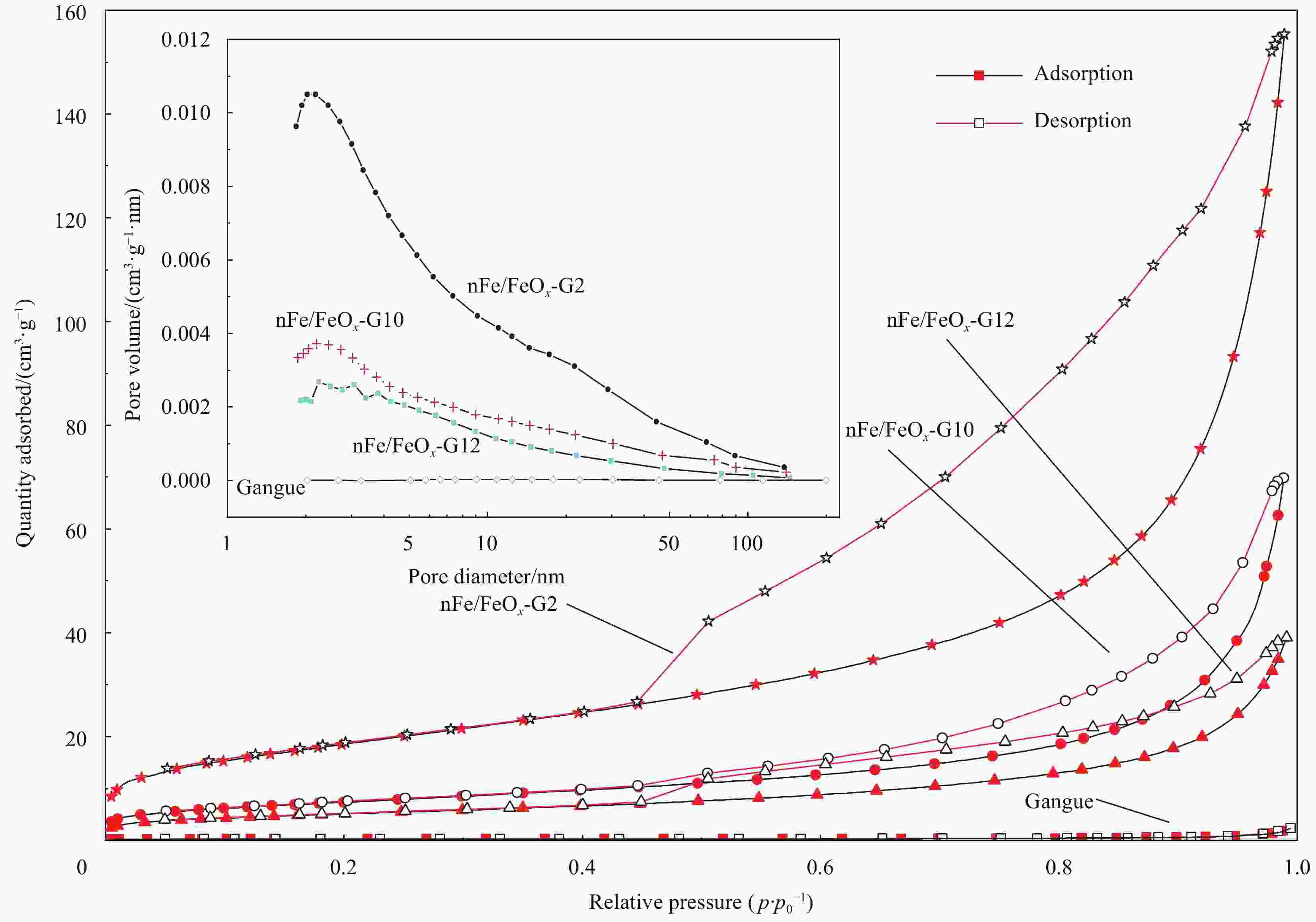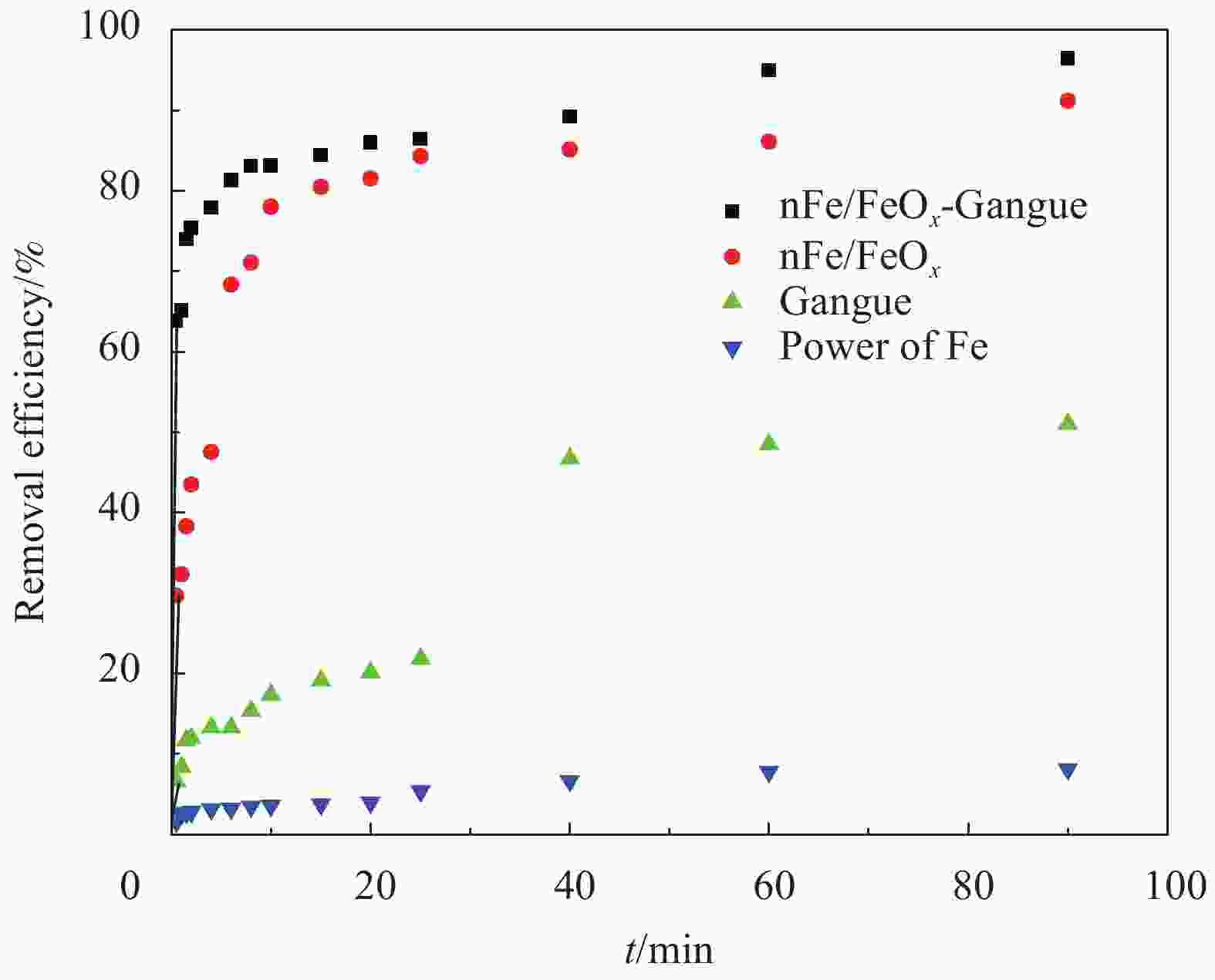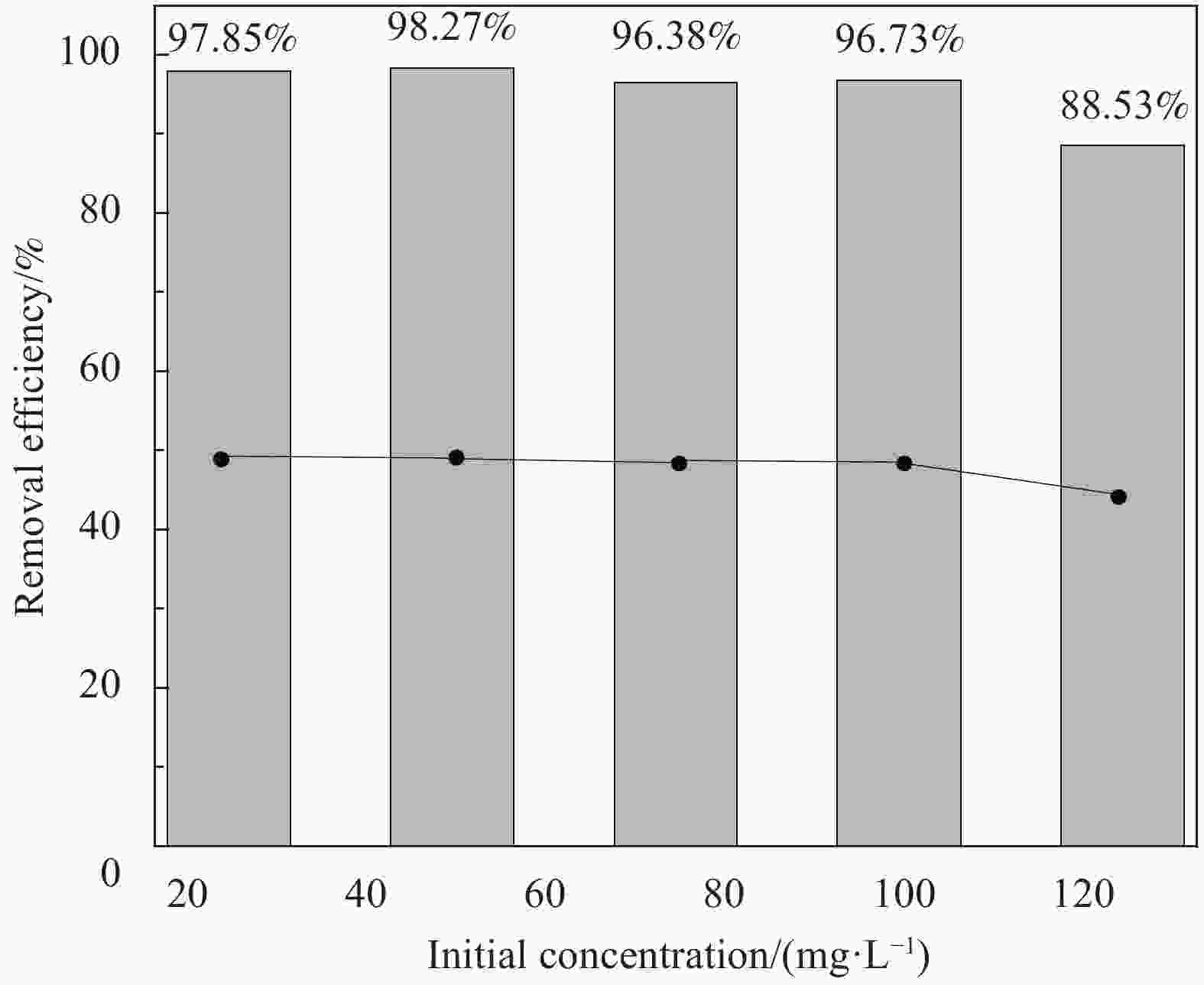Synthesis of gangue-supported Fe/FeOx nanoparticles with application for adsorption of cadmium
-
摘要: 为了采用一系列工艺对煤矸石进行提纯,采用硼氢化钠化学液相还原法制备了煤矸石负载的Fe/FeOx纳米颗粒(nFe/FeOx-Gangue),用于吸附水中重金属离子Cd(II)。在均匀设计的基础上,考察了铁与煤矸石质量比、硼铁摩尔比、还原速度等因素对nFe/FeOx-Gangue的影响。采用XRD、TEM、BET和TGA-DSC对合成的样品进行了表征,发现Fe/FeOx纳米颗粒或独立存在于煤矸石表面,或串联成链吸附在矿物表面、尖锐的边缘和角缘,其中固定在粘土矿物表面的颗粒大部分呈球形,分散良好,偶有少量球状或块状聚集体。多个样品比对结果显示,铁与煤矸石质量比(g/g)应保持在1.6,合适的硼铁摩尔比为4或4.5。吸附结果显示,nFe/FeOx-Gangue对Cd(II)的去除效果在很大程度上取决于pH值,pH值为5,室温条件下接触10 min后,nFe/FeOx-Gangue对Cd(II)的去除率达83%,再生的nFe/FeOx-Gangue在5.0 mg/L溶液中连续第6次吸附Cd(II)效率达99.12%,煤矸石负载的Fe/FeOx纳米颗粒可应用于水中重金属离子的吸附。
-
关键词:
- 煤矸石 /
- Fe/FeOx纳米颗粒 /
- 湿法生长 /
- 吸附 /
- 镉
Abstract: In this paper, gangue was purified by a series of process and gangue-supported Fe/FeOx nanoparticles (nFe/FeOx-Gangue) were prepared by the liquid-phase reduction method under open atmosphere. The factors including Fe:Gangue mass ratios, B:Fe molar ratios, and the reduction speed were investigated based on a uniform design. XRD, TEM, BET and TG-DTA analysis were used for characterization of synthesized samples. The synthesized nFe/FeOx-Gangue exists on the surface of gangue or adsorbed on surface, sharp edges and angles of small clay in series with an analogous catenulate formation in rank, indicating that the spherical particles immobilized on clay are clearly separated and well dispersed, displaying small amounts of globular or nubbly aggregates. The comparison results of several samples show that the Fe/ Gangue mass ratio (g/g) should be maintained as 1.6, and the appropriate B/Fe molar ratios are 4 or 4.5. After contacting with nFe/FeOx-Gangue for 10 min, for Cd(II), the adsorption efficiency on nFe/FeOx-Gangue is 83% at pH 5.0. The removal efficiency of Cd(II) on nFe/FeOx-Gangue is largely dependent on pH values. The reusability of nFe/FeOx-Gangue is evaluated and the results indicate that the reborn nFe/FeOx-Gangue even could adsorb 99.12% of Cd(II) ions in 5.0 mg/L solution for the sixth successive uses. nFe/FeOx-Gangue is appropriate to remove Cd(II).-
Key words:
- gangue /
- Fe/FeOx nanoparticles /
- wet growth /
- adsorption /
- cadmium
-
表 1 提纯煤矸石、市售蒙脱石和高岭石的化学组成对比
Table 1. Chemical composition of purified gangue, montmorillonite, and kaolinite
wt% Sample SiO2 Al2O3 P2O5 Na2O K2O Fe2O3 TiO2 MgO CaO MnO SO3 Total Gangue 44.89 20.99 13.301 4.21 1.21 1.16 0.737 0.32 0.05 0.004 0.02 86.89 Montmorillonite 74.55 14.55 0.002 0.28 1.54 0.52 0.118 2.32 2.4 0.064 0.02 96.35 Kaolinite 75.36 14.04 0.002 2.29 5.2 0.91 0.066 0.65 1.4 0.033 0.02 100.01 表 2 煤矸石负载的Fe/FeOx纳米颗粒(nFe/FeOx-Gangue)的制备条件
Table 2. Synthesis conditions for gangue-supported Fe/FeOx nanoparticles (nFe/FeOx-Gangue) samples
Sample Factor 1 Factor 2 Factor 3 Fe/Gangue mass ratio B/Fe molar ratio Reduction speed/(mL·min−1) nFe/FeOx-G1 1∶5 7∶2 21.05 nFe/FeOx-G2 2∶5 13∶2 10.52 nFe/FeOx-G3 1∶2 3∶1 5.17 nFe/FeOx-G4 3∶5 6∶1 3.73 nFe/FeOx-G5 4∶5 5∶2 29 nFe/FeOx-G6 1∶1 11∶2 11.7 nFe/FeOx-G7 6∶5 2∶1 7.65 nFe/FeOx-G8 7∶5 5∶1 4.42 nFe/FeOx-G9 3∶2 3∶2 54.55 nFe/FeOx-G10 8∶5 9∶2 15.38 nFe/FeOx-G11 9∶5 1∶1 11.47 nFe/FeOx-G12 2∶1 4∶1 4.85 Note: G—Gangue. 表 3 提纯煤矸石和nFe/FeOx-Gangue的比表面积、孔体积和吸附平均孔宽
Table 3. Specific surface area, pore volume and adsorption average pore width of purified gangue and nFe/FeOx-Gangue samples
Sample Gangue nFe/FeOx-G2 nFe/FeOx-G10 nFe/FeOx-G12 SBET/(m2·g−1) 0.82 67.96 26.73 18.35 Vpore/(cm3·g−1) 0.003 0.243 0.109 0.061 Average pore width/nm 8.59 10.66 11.77 10.11 Note: SBET—Surface area, calculated from the relative pressures between 0.06 and 0.2; Vpore—Pore volume. 表 4 nFe/FeOx-Gangue吸附Cd(II)的动力学模型拟合参数
Table 4. Adsorption kinetic model rate constants for Cd(II) adsorption on nFe/FeOx-Gangue
$ {{{q}}}_{{\rm{e}},{\rm{e}}{\rm{x}}{\rm{p}}} $/(mg·g−1) Pseudo first-order model Pseudo second-order model $ {{{k}}}_{1} $/min−1 $ {{{q}}}_{{\rm{e}},{\rm{c}}{\rm{a}}{\rm{l}}} $/(mg·g−1) r12 $ {{{k}}}_{2} $/(g·mg−1·min−1) $ {q}_{{\rm{e}},{\rm{c}}{\rm{a}}{\rm{l}}} $/(mg·g−1) r22 12.23 −0.0321 12.4329 0.9467 0.0117 10.9218 0.8784 Notes: $ {q}_{{\rm{e}},{\rm{e}}{\rm{x}}{\rm{p}}} $—Experimentally determined equilibrium capacity; $ {q}_{{\rm{e}},{\rm{c}}{\rm{a}}{\rm{l}}} $—Simulated equilibrium capacity; $ {k}_{1} $—Pseudo-first-order rate constant; $ {k}_{2} $—Pseudo-second-order rate constant; r12—Linear regression coefficient from pseudo first-order model; r22—Linear regression coefficient from pseudo second-order model; Pseudo first-order model—${\rm{lg} }\left({q}_{ {\rm{e} } }-{q}_{ {{t} } }\right)={\rm{lg} }{q}_{ {\rm{e} } }-\dfrac{ {k}_{1} }{2.303}t$, $ {k}_{1} $ and $ {q}_{{\rm{e}},{\rm{e}}{\rm{x}}{\rm{p}}} $ were evaluated using the slopes and intercepts of the linear plots of ${\rm{lg} }\left({q}_{ {\rm{e} } }-{q}_{ { {t} } }\right)$ versus t; Pseudo second-order model—$ \dfrac{t}{{q}_{{{t}}}}=\dfrac{1}{{k}_{2}{{q}_{{\rm{e}}}}^{2}}+\dfrac{1}{{q}_{{\rm{e}}}}t $, $ {q}_{{\rm{e}},{\rm{ }}{\rm{c}}{\rm{a}}{\rm{l}}} $ and $ {k}_{2} $ can be determined from the slope and intercept of plots of $ t/{q}_{{{t}}} $ versus time ($ t $). 表 5 nFe/FeOx-Gangue吸附Cd(II)的吸附等温线模型拟合参数
Table 5. Freundlich and Langmuir adsorption parameters for adsorption of Cr(VI) on nFe/FeOx-Gangue
Adsorbents Langmuir equation parameters Freundlich equation parameters qm/(mg·g−1) R2 qm/(mg·g−1) R2 nFe/FeOx−Gangue 29.04 0.648 149.53 0.975 Notes: $ {q}_{{\rm{m}}} $—Maximum adsorption capacity; R2—Linear regression coefficient. -
[1] HUANG X, ZHANG F, PENG K, et al. Effect and mechanism of graphene structured palladized zero-valent iron nanocomposite (nFe/FeOx-Pd/NG) for water denitration[J]. Scientific Reports,2020,10(1):1-11. [2] BEZZA F A , CHIRWA E . Removal of phosphate from contaminated water using activated carbon supported nanoscale zero-valent iron (nZVI) particles[J]. Chemical Engineering Transactions, 2021, 84: 55-60. [3] BIN Q, LIN B, ZHU K, et al. Superir trichloroethylene removal from water by sulfide-modified nanoscale zero-valent iron/graphene aerogel composite[J]. Journal of Environmental Sciences,2020,88:90-102. doi: 10.1016/j.jes.2019.08.011 [4] EL-TEMSAH Y S, SEVCU A, BOBCIKOVA K, et al. DDT degradation efficiency and ecotoxicological effects of two types of nano-sized zero-valent iron (nZVI) in water and soil[J]. Chemosphere,2016,144:2221-2228. doi: 10.1016/j.chemosphere.2015.10.122 [5] KHUDHAIR E M, AMMAR S H, JABBAR H. Phosphotungstic acid immobilized onto ZnO coated zerovalent iron (Fe@ZnO/PW) core/shell magnetic nanocomposite for enhanced photocatalytic bacterial inactivation under visible light[J]. Journal of Photochemistry and Photobiology A: Chemistry,2021,404:112907. doi: 10.1016/j.jphotochem.2020.112907 [6] STEFANIUK M, OLESZCZUK P, OK Y S. Review on nano zerovalent iron (nZVI): From synthesis to environmental applications[J]. Chemical Engineering Journal, 2016, 287: 618-632. [7] KOPINKE F D, SÜHNHOLZ S, GEORGI A, et al. Interaction of zero-valent iron and carbonaceous materials for reduction of DDT[J]. Chemosphere,2020,253:126712. doi: 10.1016/j.chemosphere.2020.126712 [8] CHEN X, LI X, XU D, et al. Application of nanoscale zero-valent iron in hexavalent chromium-contaminated soil: A review[J]. Nanotechnology Reviews,2020,9(1):736-750. doi: 10.1515/ntrev-2020-0059 [9] HU B, CHEN G, JIN C, et al. Macroscopic and spectroscopic studies of the enhanced scavenging of Cr(VI) and Se(VI) from water by titanate nanotube anchored nanoscale zero-valent iron[J]. Journal of Hazardous Materials,2017,336:214-221. [10] LI S, WANG W, LIANG F, et al. Heavy metal removal using nanoscale zero-valent iron (nZVI): Theory and application[J]. Journal of Hazardous Materials,2017,322:163-171. doi: 10.1016/j.jhazmat.2016.01.032 [11] KIM D G, HWANG Y H, SHIN H S, et al. Kinetics of nitrate adsorption and reduction by nano-scale zero valent iron (NZVI): Effect of ionic strength and initial pH[J]. KSCE Journal of Civil Engineering,2016,20(1):175-187. doi: 10.1007/s12205-015-0464-3 [12] VILARDI G, VERDONE N, DI PALMA L. The influence of nitrate on the reduction of hexavalent chromium by zero-valent iron nanoparticles in polluted wastewater[J]. Desalination and Water Treatment,2017,86:252-258. doi: 10.5004/dwt.2017.20710 [13] ROY E, PATRA S, KARFA P, et al. Role of magnetic nanoparticles in providing safe and clean water to each individual[M]//Complex Magnetic Nanostructures. Heidelberg: Springer International Publishing, 2017: 281-316. [14] SU J, CHEN H, WANG J, et al. Enhanced dechlorination of carbon tetrachloride by Ni-doped zero-valent iron nanoparticles @ magnetic Fe3O4 (Ni4/Fe@Fe3O4) nanocomposites[J]. Colloids and Surfaces A Physicochemical and Engineering Aspects,2021,623:126691. doi: 10.1016/j.colsurfa.2021.126691 [15] AFROOSHEH F, BAKHTIARI S, SHAHRASHOUB M, et al. Green synthesis of nanoscale zero-valent iron/activated carbon composites and their application for copper and chromium removal from aqueous Solutions[J]. Journal of Nano Research,2021,66:129-142. doi: 10.4028/www.scientific.net/JNanoR.66.129 [16] HATTI V, SINGH Y V, SHARMA S K, et al. Application of nano technology in crop production to enhance resource use efficiency with special reference to soil and water conservation: A review[J]. Journal of Soil and Water Conservation,2021,19(4):375-381. [17] HUA D A, YL A, WC A, et al. Multifunctional magnetic bio-nanoporous carbon material based on zero-valent iron, angelicae dahuricae radix slag and graphene oxide: An efficient adsorbent of pesticides[J]. Arabian Journal of Chemistry,2021,14(8):103267. doi: 10.1016/j.arabjc.2021.103267 [18] YU X. Coal mining and environmental development in southwest China[J]. Environmental Development,2017,21:77-86. doi: 10.1016/j.envdev.2016.12.001 [19] LIANG Y, LIANG H, ZHU S. Mercury emission from spontaneously ignited coal gangue hill in Wuda coalfield, Inner Mongolia, China[J]. Fuel,2016,182:525-530. doi: 10.1016/j.fuel.2016.05.092 [20] WU H, WEN Q, HU L, et al. Feasibility study on the application of coal gangue as landfill liner material[J]. Waste Management,2017,63:161-171. doi: 10.1016/j.wasman.2017.01.016 [21] ZUO T F. Comprehensive utilization of coal gangue[J]. Coal Technology,2009,28:186-189. [22] ZHOU C, LIU G, WU S, et al. The environmental characteristics of usage of coal gangue in bricking-making: A case study at Huainan, China[J]. Chemosphere,2014,95:274-280. doi: 10.1016/j.chemosphere.2013.09.004 [23] ZHOU C, LIU G, WU D, et al. Mobility behavior and environmental implications of trace elements associated with coal gangue: a case study at the Huainan Coalfield in China[J]. Chemosphere,2014,95:193-199. doi: 10.1016/j.chemosphere.2013.08.065 [24] ZHOU C, LIU G, CHENG S, et al. The environmental geochemistry of trace elements and naturally radionuclides in a coal gangue brick-making plant[J]. Scientific reports,2014,4:6221. [25] XU G L, SUN C M, SUN Y. A new comprehensive utilization method for coal gangue: preparing alite-sulphoaluminate cement[J]. Advanced Materials Research,2013,652-654:1527-1532. doi: 10.4028/www.scientific.net/AMR.652-654.1527 [26] LI J Y, YOU L F, WEI Y. The current situation of comprehensive utilization of coal gangue in China[J]. Advanced Materials Research,2012,524-527:915-918. doi: 10.4028/www.scientific.net/AMR.524-527.915 [27] QIU G, LUO Z, SHI Z, et al. Utilization of coal gangue and copper tailings as clay for cement clinker calcinations[J]. Journal of Wuhan University of Technology-Materials Science Edition,2011,26(6):1205-1210. doi: 10.1007/s11595-011-0391-1 [28] MENG F M, WAN J F, LI H X. Theoretical and numerical analysis of waste heat utilization device for coal gangue brick tunnel kiln[J]. Advanced Materials Research,2011,301-303:1517-1521. doi: 10.4028/www.scientific.net/AMR.301-303.1517 [29] WANG S, ZHAO M, ZHOU M, et al. Biochar-supported nZVI (nZVI/BC) for contaminant removal from soil and water: A critical review[J]. Journal of Hazardous Materials, 2019, 373: 820-834. [30] ZHAO X, LIU W, CAI Z, et al. An overview of preparation and applications of stabilized zero-valent iron nanoparticles for soil and groundwater remediation[J]. Water Research, 2016, 100: 245-266. [31] BERGAYA F, THENG B K J, LAGALY G. Handbook of clay science, Developments in clay science vol.1[M]. Amsterdam/London: Elsevier, 2006 [32] ÜZÜM C, SHAHWAN T, EROGLU A E, et al. Synthesis and characterization of kaolinite-supported zero-valent iron nanoparticles and their application for the removal of aqueous Cu2+ and Co2+ ions[J]. Applied Clay Science,2009,43(2):172-181. doi: 10.1016/j.clay.2008.07.030 [33] SHAHWAN T, ÜZÜM C, EROGLU A E, et al. Synthesis and characterization of bentonite/iron nanoparticles and their application as adsorbent of cobalt ions[J]. Applied Clay Science,2010,47(3-4):257-262. doi: 10.1016/j.clay.2009.10.019 [34] PETALA E, DIMOS K, DOUVALIS A, et al. Nanoscale zero-valent iron supported on mesoporous silica: Characterization and reactivity for Cr (VI) removal from aqueous solution[J]. Journal of Hazardous Materials,2013,261:295-306. doi: 10.1016/j.jhazmat.2013.07.046 [35] LIU Y, MAJETICH S A, TILTON R D, et al. TCE dechlorination rates, pathways, and efficiency of nanoscale iron particles with different properties[J]. Environmental Science & Technology,2005,39(5):1338-1345. [36] WANG J, LIU G, ZHOU C, et al. Synthesis, characterization and aging study of kaolinite-supported zero-valent iron nanoparticles and its application for Ni (II) adsorption[J]. Materials Research Bulletin,2014,60:421-432. doi: 10.1016/j.materresbull.2014.09.016 [37] ÜZÜM Ç, SHAHWAN T, EROĞLU A E, et al. Application of zero-valent iron nanoparticles for the removal of aqueous Co2+ ions under various experimental conditions[J]. Chemical Engineering Journal,2008,144:213-220. doi: 10.1016/j.cej.2008.01.024 [38] NURMI J T, TRATNYEK P G, SARATHY V, et al. Characterization and properties of metallic iron nanoparticles: Spectroscopy, electrochemistry, and kinetics[J]. Environmental Science & Technology,2005,39(5):1221-1230. [39] SUN Y P, LI X, CAO J, et al. Characterization of zero-valent iron nanoparticles[J]. Advances in Colloid and Interface Science,2006,120(1):47-56. [40] LIN K, DING J, HUANG X. Debromination of tetrabromobisphenol a by nanoscale zerovalent iron: Kinetics, influenc-ing factors, and pathways[J]. Industrial & Engineering Chemistry Research,2012,51(25):8378-8385. [41] WANG J, LIU G, QI C, et al. Synthesis and characterization of montmorillonite-supported zero-valent iron nanoparticles with application for preconcentration of zinc[J]. Analytical Letters,2016,49(17):2766-2782. doi: 10.1080/00032719.2016.1159219 [42] MAZO-ZULUAGA J, BARRERO C, DIAZ-TERAN J, et al. Thermally induced magnetite-haematite transformation[J]. Hyperfine Interactions,2003,148:153-161. [43] YUAN P, FAN M, YANG D, et al. Montmorillonite-supported magnetite nanoparticles for the removal of hexavalent chromium [Cr(VI)] from aqueous solutions[J]. Journal of Hazardous Materials,2009,166:821-829. doi: 10.1016/j.jhazmat.2008.11.083 [44] YUAN P, LIU D, FAN M, et al. Removal of hexavalent chromium [Cr(VI)] from aqueous solutions by the diatomite-supported/unsupported magnetite nanoparticles[J]. Journal of Hazardous Materials,2010,173:614-621. doi: 10.1016/j.jhazmat.2009.08.129 [45] XU S P, ZHU G J. The preparation method of nanometer iron oxide using ultrasonic, homogeneous precipitation[J]. Coatings Industry, China,2005,35:231-33. [46] LI S Z, WU P X, LI H L, et al. Synthesis and characterization of organo-montmorillonite supported iron nanoparticles[J]. Applied Clay Science,2010,50:330-336. doi: 10.1016/j.clay.2010.08.021 [47] ZHANG H, JIN Z, LU H, et al. Synthesis of nanoscale zero-valent iron supported on exfoliated graphite for removal of nitrate[J]. Transactions of Nonferrous Metals Society of China,2006,16:s345-s349. doi: 10.1016/S1003-6326(06)60207-0 [48] LIMOUSIN G, GAUDET J P, CHARLET L, et al. Sorption isotherms: A review on physical bases, modeling and measurement[J]. Applied Geochemistry,2007,22(2):249-275. doi: 10.1016/j.apgeochem.2006.09.010 [49] YANG C H. Statistical mechanical study on the freundlich isotherm equation[J]. Journal of Colloid and Interface Science,1998,208:379-387. doi: 10.1006/jcis.1998.5843 [50] 严新. 均匀纺锤形α-Fe2O3的制备及其等电性研究[J]. 华东理工大学学报(自然科学版), 2004, 5(5):536-538. doi: 10.3969/j.issn.1006-3080.2004.05.012YAN X. Preparation of monodisperse spindle-type hematite ultra-fine particles and study on its isoelectric phenomenon[J]. Journal of East China University of Science and Technology (Natural Science Edition),2004,5(5):536-538(in Chinese). doi: 10.3969/j.issn.1006-3080.2004.05.012 [51] ZHANG X, LIN S, LU X Q, et al. Removal of Pb(II) from water using synthesized kaolin supported nanoscale zero-valent iron[J]. Chemical Engineering Journal,2010,163:243-248. doi: 10.1016/j.cej.2010.07.056 -





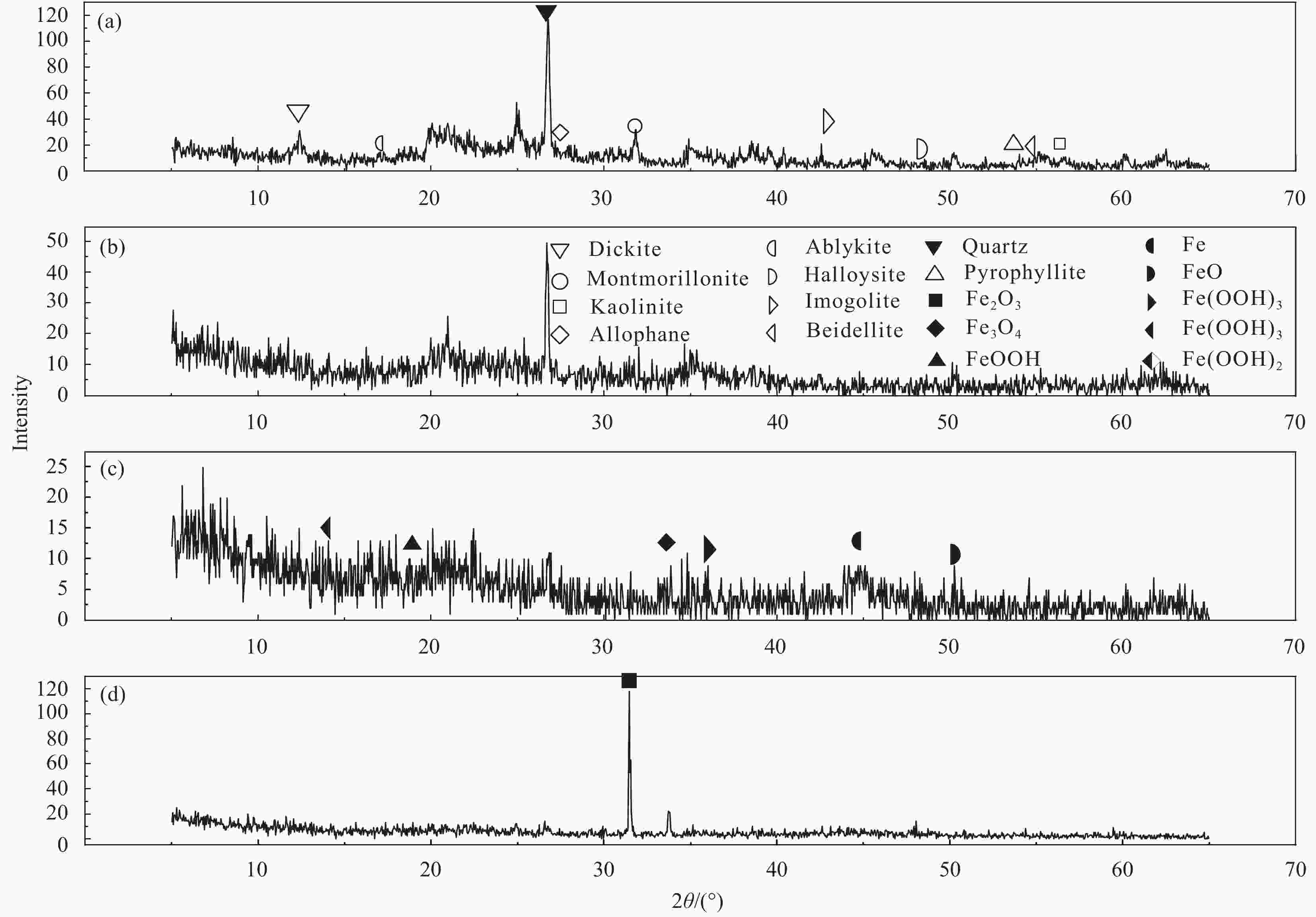
 下载:
下载:
